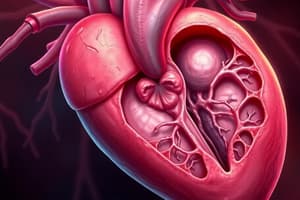Podcast
Questions and Answers
What causes the changes in the vascular system at birth?
What causes the changes in the vascular system at birth?
- Closure of the septum primum
- Increase in placental blood flow
- Cessation of placental blood flow and beginning of respiration (correct)
- Decrease in lung vessel constriction
In complete transposition of the great blood vessels, what happens to the position of the heart apex?
In complete transposition of the great blood vessels, what happens to the position of the heart apex?
- It becomes inferior and to the right side (correct)
- It becomes superior
- It remains in the same position
- It moves to the left side
Which heart defect is associated with ventricular inversion?
Which heart defect is associated with ventricular inversion?
- Coarctation of the aorta
- Dextrocardia (correct)
- Atrial septal defect
- Patent ductus arteriosus
What causes an increase in pressure in the left atrium after birth?
What causes an increase in pressure in the left atrium after birth?
Which structure plays a role in closing the ductus arteriosus after birth?
Which structure plays a role in closing the ductus arteriosus after birth?
In what direction is the heart apex positioned in dextrocardia?
In what direction is the heart apex positioned in dextrocardia?
How does the heart tube form during embryological development?
How does the heart tube form during embryological development?
What is the significance of the craniocaudal fusion of the heart tubes during development?
What is the significance of the craniocaudal fusion of the heart tubes during development?
In the context of cardiac development, how is complete transposition of the great blood vessels explained embryologically?
In the context of cardiac development, how is complete transposition of the great blood vessels explained embryologically?
How does fetal circulation change after birth and relate to congenital heart defects?
How does fetal circulation change after birth and relate to congenital heart defects?
Which clinical syndrome affecting the heart is most likely associated with generalized cyanosis shortly after birth?
Which clinical syndrome affecting the heart is most likely associated with generalized cyanosis shortly after birth?
Why was the infant with complete transposition of great blood vessels able to survive after birth despite having this severe anomaly?
Why was the infant with complete transposition of great blood vessels able to survive after birth despite having this severe anomaly?
What causes the closure of the communication between the two atria at birth?
What causes the closure of the communication between the two atria at birth?
Which of the following conditions is associated with the aorta originating from the right ventricle and the pulmonary artery originating from the left ventricle?
Which of the following conditions is associated with the aorta originating from the right ventricle and the pulmonary artery originating from the left ventricle?
Which abnormality involves anterior displacement of the spiral septum and includes pulmonary stenosis and overriding of the aorta?
Which abnormality involves anterior displacement of the spiral septum and includes pulmonary stenosis and overriding of the aorta?
What is primarily found in the muscular portion of the interventricular septum?
What is primarily found in the muscular portion of the interventricular septum?
Which defect is usually accompanied by an open ductus arteriosus and may involve a defect in the membranous part of the interventricular septum?
Which defect is usually accompanied by an open ductus arteriosus and may involve a defect in the membranous part of the interventricular septum?
What leads to hypertrophy of the right ventricular wall in Tetralogy of Fallot?
What leads to hypertrophy of the right ventricular wall in Tetralogy of Fallot?
Flashcards are hidden until you start studying



